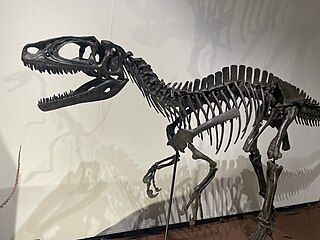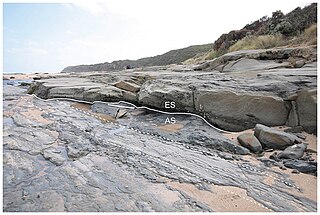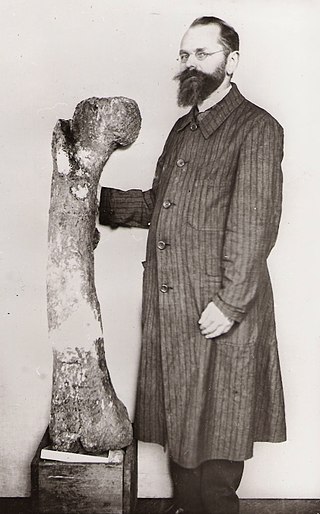
Neovenator is a genus of carcharodontosaurian theropod dinosaur. It is known from several skeletons found in the Early Cretaceous (Hauterivian-Barremian) Wessex Formation on the south coast of the Isle of Wight, southern England. It is one of the best known theropod dinosaurs from the Early Cretaceous of Europe.

Fukuiraptor was a medium-sized megaraptoran theropod dinosaur of the Early Cretaceous epoch that lived in what is now Japan. Fukuiraptor is known from the Kitadani Formation and possibly also the Sebayashi Formation.

Chilantaisaurus is a genus of large theropod dinosaur, possibly a neovenatorid or a primitive coelurosaur, from the Late Cretaceous Ulansuhai Formation of China. The type species, C. tashuikouensis, was described by Hu in 1964.

Deltadromeus is a genus of theropod dinosaur from the Aoufous Formation of Morocco.

Megaraptor is a genus of large theropod dinosaur that lived in the ages of the Late Cretaceous. Its fossils have been discovered in the Patagonian Portezuelo Formation of Argentina, South America. Initially thought to have been a giant dromaeosaur-like coelurosaur, it was classified as a neovenatorid allosauroid in previous phylogenies, but more recent phylogeny and discoveries of related megaraptoran genera has placed it as either a basal tyrannosauroid or a basal coelurosaur with some studies still considering it a neovenatorid.

Noasauridae is an extinct family of theropod dinosaurs belonging to the group Ceratosauria. They were closely related to the short-armed abelisaurids, although most noasaurids had much more traditional body types generally similar to other theropods. Their heads, on the other hand, had unusual adaptations depending on the subfamily. 'Traditional' noasaurids, sometimes grouped in the subfamily Noasaurinae, had sharp teeth which splayed outwards from a downturned lower jaw.

Orkoraptor is a genus of medium-sized megaraptoran theropod dinosaur from the late Cretaceous Period of Argentina. It is known from incomplete fossil remains including parts of the skull, teeth, tail vertebrae, and a partial tibia. The specialized teeth resemble those of some maniraptoriform theropods, namely the deinonychosaurs and compsognathids. This and other anatomical features led the authors who described it to suggest that it was a maniraptoran coelurosaur. However, subsequent studies found it to be a megaraptoran. Found in the Cerro Fortaleza Formation of Southern Patagonia, it is one of the southernmost carnivorous dinosaurs known from South America.

Aerosteon is a genus of megaraptoran dinosaur from the Late Cretaceous period of Argentina. Its remains were discovered in 1996 in the Anacleto Formation, which is from the late Campanian. The type and only known species is A. riocoloradensis. Its specific name indicates that its remains were found 1 km north of the Río Colorado, in Mendoza Province, Argentina.

The Eumeralla Formation is a geological formation in Victoria, Australia whose strata date back to the Early Cretaceous. It is Aptian to Albian in age. Dinosaur remains are among the fossils that have been recovered from the formation, particularly from the Dinosaur Cove locality.

Bahariasauridae is a potential family of averostran theropods that might include a handful of African and South American genera, such as Aoniraptor, Bahariasaurus, Deltadromeus, and Gualicho. The placement of these theropods is controversial, with some studies placing them as basal ceratosaurs possibly related to Noasauridae, others classifying them as megaraptorans, basal neovenatorids, or basal coelurosaurs. There is also a possibility the group might not be monophyletic, as a monograph on the vertebrate diversity in the Kem Kem Beds published in 2020 found Bahariasaurus to be nomen dubium. In the same paper Deltadromeus is classified as an noasaurid, a result also recovered by some previous studies. A 2024 analysis found Aoniraptor, Bahariasaurus, Deltadromeus, Elaphrosaurus and Gualicho to form a monophyletic clade at the base of Ceratosauria.

Australovenator is a genus of megaraptoran theropod dinosaur from Cenomanian -age Winton Formation of Australia. It is known from partial cranial and postcranial remains which were described in 2009 by Scott Hocknull and colleagues, although additional descriptions and analyses continue to be published. It is the most complete predatory dinosaur discovered in Australia. It has been suggested that Australovenator is a sister taxon to Fukuiraptor, although some phylogenetic analyses find it to be a more derived member of the Megaraptora, possibly being part of the main Megaraptoridae family itself.

Megaraptora is a clade of carnivorous theropod dinosaurs with controversial relationships to other tetanuran theropods. Its derived members, the Megaraptoridae are noted for their large hand claws and powerfully-built forelimbs, which are usually reduced in size in other large theropods.

Proceratosauridae is a family or clade of tyrannosauroid theropod dinosaurs from the Middle Jurassic to the Early Cretaceous.

Pamparaptor is an extinct genus of maniraptoran theropod dinosaur from the Late Cretaceous Portezuelo Formation of the Neuquén province in Argentine Patagonia. Its precise classification is uncertain, but it is definitely a member of Paraves and probably a deinonychosaur. The authors who described it have argued that it is a dromaeosaurid. The genus contains a single species, P. micros, which is known from a single specimen consisting of a mostly complete and fully-articulated left foot, which preserves the iconic dromaeosaur-like "killing claw".

Siats (/see-ats/) is an extinct genus of large theropod dinosaur known from the Late Cretaceous Cedar Mountain Formation of Utah, United States. It contains a single species, Siats meekerorum. It was initially classified as a megaraptoran, a clade of large theropods with very controversial relationships. Siats may be a neovenatorid allosauroid, a coelurosaur of uncertain phylogenetic position, or a tyrannosauroid.
Gualicho is a genus of theropod dinosaur. The type species is Gualicho shinyae. It lived in what is now northern Patagonia, on what was then a South American island continent split off from the supercontinent Gondwana. The fossils were found in the Huincul Formation, dating to the late Cenomanian-early Turonian age of the upper Cretaceous Period, around 91 million years ago.

Murusraptor is a genus of carnivorous megaraptoran theropod dinosaur from the Sierra Barrosa Formation, part of the Neuquén Group of Patagonia, in Argentina, South America. It is known from a single specimen that consists of a partial skull, ribs, partial pelvis, leg and other assorted skeletal elements.

Tratayenia is an extinct genus of megaraptoran theropod dinosaurs known from remains found in the Santonian-age Bajo de la Carpa Formation of Argentina. The type and only species, Tratayenia rosalesi, was described in March 2018.

Phuwiangvenator is an extinct genus of megaraptoran theropod that lived during the Early Cretaceous period in what is now Thailand. It contains only the type species, P. yaemniyomi. The generic name of Phuwiangvenator comes from the Phu Wiang mountains, where the holotype was discovered, and the Latin word "venator" meaning hunter. The specific name, "yaemniyomi", is in honor of Sudham Yaemniyom, who was a historical paleontologist from Thailand and the first person to discover fossils there.

Overoraptor is an extinct genus of paravian theropod of uncertain affinities from the Late Cretaceous Huincul Formation of Argentinian Patagonia. The genus contains a single species, O. chimentoi, known from several bones of the hands, feet, and hips alongside some vertebrae.


































